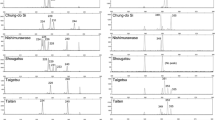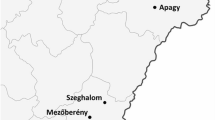Abstract
Pollination-constant non-astringent (PCNA) trait is desirable in persimmon production because it confers natural astringency loss in mature persimmon fruit. Expression of the PCNA trait requires six homozygous recessive PCNA (ast) alleles at the single ASTRINGENCY (AST) locus in hexaploid persimmon. When crossing non-PCNA accessions to breed PCNA offspring, knowledge of ast and non-PCNA (AST) allele dosage in the parental accessions is important, because more PCNA offspring can segregate from a non-PCNA parent with more ast and fewer AST alleles. Previously, we have demonstrated that a region linked to the AST locus has numerous fragment size polymorphisms with varying numbers of simple sequence repeats. Here, we reveal the polymorphisms in this region in a broad collection of persimmon germplasms. Among 237 accessions, we distinguished 21 AST- and 5 ast-linked fragments with different sizes. Based on the number of fragments detected per individual, we identified 21 non-PCNA accessions with three different ast alleles; by crossing these with a PCNA parent, we obtain PCNA offspring under autohexaploid inheritance. Furthermore, AST and ast allelic combination patterns in hexaploid persimmon were shown to be applicable to cultivar identification of non-PCNA accessions. We directly sequenced ast-linked fragments from 48 accessions with one-size peak of ast-linked fragment and found two distinctive groups of fragments based on single nucleotide polymorphisms. This result suggests that a bottleneck event occurred during ast allele development. We conclude that our fragment size profile can be used to accelerate PCNA breeding that uses non-PCNA parents and to study ast allele accumulation in persimmon.



Similar content being viewed by others
References
Agricultural Research Station (1912) Investigation on persimmon cultivars. Bull Agric Res Stn (extra) 28:1–46 (in Japanese)
Akagi T, Kanzaki S, Gao M, Tao R, Parfitt DE, Yonemori K (2009) Quantitative real-time PCR to determine allele number for the astringency locus by analysis of a linked marker in Diospyros kaki Thunb. Tree Genet Genomes 5:483–492. https://doi.org/10.1007/s11295-009-0202-4
Akagi T, Takeda Y, Yonemori K, Ikegami A, Kono A, Yamada M, Kanzaki S (2010) Quantitative genotyping for the astringency locus in hexaploid persimmon cultivars using quantitative real-time PCR. J Am Soc Hortic Sci 135:59–66
Akagi T, Tao R, Tsujimoto T, Kono A, Yonemori K (2012) Fine genotyping of a highly polymorphic ASTRINGENCY-linked locus reveals variable hexasomic inheritance in persimmon (Diospyros kaki Thunb.) cultivars. Tree Genet Genomes 8:195–204. https://doi.org/10.1007/s11295-011-0432-0
Allard RW (1960) Principles of plant breeding. Wiley, New York and London, pp 390–399
Badenes M, Garcés A, Romero C, Romero M, Clavé J, Rovira M, Llácer G (2003) Genetic diversity of introduced and local Spanish persimmon cultivars revealed by RAPD markers. Genet Resour Crop Evol 50:579–585. https://doi.org/10.1023/A:1024474719036
Bellini E, Giordani E (2005) Germplasm and breeding of persimmon in Europe. Acta Hortic 685:65–75. https://doi.org/10.17660/ActaHortic.2005.685.6
Botstein D, White RL, Skolnick M, Davis RW (1980) Construction of a genetic linkage map in man using restriction fragment length polymorphisms. Am J Hum Genet 32:314–331
Bouquet A (1986) Introduction dans l’espèce Vitis vinifera L. d’un caractère de résistance à l’oidium (Uncinula necator Schw. Burr.) issu de l’espèce Muscadinia rotundifolia (Michx.) Small. Vignevini 12(suppl):141–146 (in French)
Brownstein MJ, Carpten JD, Smith JR (1996) Modulation of non-templated nucleotide addition by Taq DNA polymerase: primer modifications that facilitate genotyping. BioTechniques 20:1004–1010
Cho SK, Cho TH (1965) Studies on the local varieties of persimmon in Korea. Res Rep RDA 8:147–190 (in Korean with English summary)
Du X, Zhang Q, Luo Z (2009) Development of retrotransposon primers and their utilization for germplasm identification in Diospyros spp. (Ebenaceae). Tree Genet Genomes 5:235–245. https://doi.org/10.1007/s11295-008-0182-9
Fruit Tree Experiment Station of Hiroshima Prefecture (1979) Showa 53-nendo Shubyo-tokusei-bunrui-chosa-hokokusho (Kaki). Fruit Tree Experiment Station of Hiroshima Prefecture, Akitsu, Hiroshima
Guo DL, Luo ZR (2011) Genetic relationships of the Japanese persimmon Diospyros kaki (Ebenaceae) and related species revealed by SSR analysis. Genet Mol Res 10:1060–1068. https://doi.org/10.4238/vol10-2gmr1100
Ikeda I, Yamada M, Kurihara A, Nishida T (1985) Inheritance of astringency in Japanese persimmon. J Jpn Soc Hortic Sci 54:39–45. https://doi.org/10.2503/jjshs.54.39 (in Japanese with English summary)
Ikegami A, Eguchi S, Yonemori K, Yamada M, Sato A, Mitani N, Kitajima A (2006) Segregations of astringent progenies in the F1 populations derived from crosses between a Chinese pollination-constant nonastringent (PCNA) ‘Luo Tian Tian Shi’, and Japanese PCNA and pollination-constant astringent (PCA) cultivars of Japanese origin. Hortscience 41:561–563
Ikegami A, Yonemori K, Sugiura A, Sato A, Yamada M (2004) Segregation of astringency in F1 progenies derived from crosses between pollination-constant, nonastringent persimmon cultivars. Hortscience 39:371–374
Kajiura M (1946) Persimmon cultivars and their improvement 2. Breed Hortic 1:175–182 (in Japanese)
Kanzaki S, Akagi T, Masuko T, Kimura M, Yamada M, Sato A, Mitani N, Utsunomiya N, Yonemori K (2010) SCAR markers for practical application of marker-assisted selection in persimmon (Diospyros kaki Thunb.) breeding. J Jpn Soc Hortic Sci 79:150–155. https://doi.org/10.2503/jjshs1.79.150
Kanzaki S, Sato A, Yamada M, Utsunomiya N, Kitajima A, Ikegami A, Yonemori K (2008) RFLP markers for the selection of pollination-constant and non-astringent (PCNA)-type persimmon and examination of the inheritance mode of the markers. J Jpn Soc Hortic Sci 77:28–32. https://doi.org/10.2503/jjshs1.77.28
Kanzaki S, Yonemori K, Sato A, Yamada M, Sugiura A (2000) Analysis of the genetic relationships among pollination-constant and non-astringent (PCNA) cultivars of persimmon (Diospyros kaki Thunb.) from Japan and China using amplified fragment length polymorphism (AFLP). J Jpn Soc Hortic Sci 69:665–670. https://doi.org/10.2503/jjshs.69.665
Kobayashi S, Ishimaru M, Ding CK, Yakushiji H, Goto N (2001) Comparison of UDP-glucose:flavonoid 3-O-glucosyltransferase (UFGT) gene sequences between white grapes (Vitis vinifera) and their sports with red skin. Plant Sci 160:543–550. https://doi.org/10.1016/S0168-9452(00)00425-8
Kono A, Kobayashi S, Onoue N, Sato A (2016) Characterization of a highly polymorphic region closely linked to the AST locus and its potential use in breeding of hexaploid persimmon (Diospyros kaki Thunb.) Mol Breed 36:56. https://doi.org/10.1007/s11032-016-0480-0
Kono A, Onoue N, Sato A (2018) Extracting DNA from dormant buds and cambium tissue of persimmon. Acta Hortic. (in press)
Luo ZR, Yonemori K, Sugiura A (1995) Evaluation of RAPD analysis for cultivar identification of persimmons. J Jpn Soc Hortic Sci 64:535–541. https://doi.org/10.2503/jjshs.64.535 (in Japanese with English summary)
Maki S, Oyama K, Kurahashi T, Nakahira T, Kawabata T, Yamada T (2001) RFLP analysis for cultivar identification of persimmons. Sci Hortic 91:407–412. https://doi.org/10.1016/S0304-4238(01)00254-0
Mitani N, Kono A, Yamada M, Sato A, Kobayashi S, Ban Y, Ueno T, Shiraishi M, Kanzaki S, Tsujimoto T, Yonemori K (2014a) Practical marker-assisted selection using two SCAR markers for fruit astringency type in crosses of ‘Taiten’ × PCNA cultivars in persimmon breeding. Sci Hortic 170:219–223. https://doi.org/10.1016/j.scienta.2014.03.001
Mitani N, Kono A, Yamada M, Sato A, Kobayashi S, Ban Y, Ueno T, Shiraishi M, Kanzaki S, Tsujimoto T, Yonemori K (2014b) Application of marker-assisted selection in persimmon breeding of PCNA offspring using SCAR markers among the population from the cross between non-PCNA ‘Taigetsu’ and PCNA ‘Kanshu’. Hortscience 49:1132–1135
Naval MM, Zuriaga E, Pecchioli S, Llácer G, Giordani E, Badenes ML (2010) Analysis of genetic diversity among persimmon cultivars using microsatellite markers. Tree Genet Genomes 6:677–687. https://doi.org/10.1007/s11295-010-0283-0
Parfitt DE, Yonemori K, Honsho C, Nozaka M, Kanzaki S, Sato A, Yamada M (2015) Relationships among Asian persimmon cultivars, astringent and non-astringent types. Tree Genet Genomes 11:24. https://doi.org/10.1007/s11295-015-0848-z
Pasqualotto AC, Denning DW, Anderson MJ (2007) A cautionary tale: lack of consistency in allele sizes between two laboratories for a published multilocus microsatellite typing system. J Clin Microbiol 45:522–528. https://doi.org/10.1128/JCM.02136-06
Ruengphayak S, Chaichumpoo E, Phromphan S, Kamolsukyunyong W, Sukhaket W, Phuvanartnarubal E, Korinsak S, Korinsak S, Vanavichit A (2015) Pseudo-backcrossing design for rapidly pyramiding multiple traits into a preferential rice variety. Rice 8:7. https://doi.org/10.1186/s12284-014-0035-0
Sato A, Yamada M (2016) Persimmon breeding in Japan for pollination-constant non-astringent (PCNA) type with marker-assisted selection. Breed Sci 66:60–68. https://doi.org/10.1270/jsbbs.66.60
Schuelke M (2000) An economic method for the fluorescent labeling of PCR fragments. Nat Biotechnol 18:233–234. https://doi.org/10.1038/72708
Soriano JM, Pecchioli S, Romero C, Vilanova S, Llácer G, Giordani E, Badenes ML (2006) Development of microsatellite markers in polyploid persimmon (Diospyros kaki Lf) from an enriched genomic library. Mol Ecol Notes 6:368–370. https://doi.org/10.1111/j.1471-8286.2006.01236.x
Sugiura A, Yonemori K, Tetsumura T, Tao R, Yamada M, Yamane H (1990) Identification of pollination-constant and non-astringent type cultivars of Japanese persimmon by leaf isozyme analysis. J Jpn Soc Hortic Sci (supplement 1) 59:44–45 (in Japanese)
Tamura M, Tao R, Yonemori K, Utsunomiya N, Sugiura A (1998) Ploidy level and genome size of several Diospyros species. J Jpn Soc Hortic Sci 67:306–312. https://doi.org/10.2503/jjshs.67.306
Tao R, Sugiura A (1987) Cultivar identification of Japanese persimmon by leaf isozymes. Hortscience 22:932–935
Tao R, Tetsumura T, Sugiura A (1989) Use of leaf isozymes to discriminate among Japanese persimmon (Diospyros kaki L.) cultivars. Mem Coll Agric Kyoto Univ 135:31–42
Wang R (1982) The origin of ‘Luotian-Tianshi’. Chinese Fruit Tree 2:16–19 (in Chinese)
Wang R, Yong Y, Gaochao L (1997) Chinese persimmon germplasm resources. Acta Hortic 436:43–50. https://doi.org/10.17660/ActaHortic.1997.436.3
Yamada M (1993) Persimmon breeding in Japan. Jpn Agric Res Q 27:33–37
Yamada M (1996a) Aizu Mishirazu. In: Kozaki I, Ueno I, Tsuchiya S, Kajiura I (eds) Shinpen Genshoku Kudamono Zusetsu, 1st edn. Yokendo, Tokyo, pp 204–205 (in Japanese with English summary)
Yamada M (1996b) Ichida Gaki. In: Kozaki I, Ueno I, Tsuchiya S, Kajiura I (eds) Shinpen Genshoku Kudamono Zusetsu, 1st edn. Yokendo, Tokyo, pp 196–197 (in Japanese with English summary)
Yamada M (1996c) Saijo. In: Kozaki I, Ueno I, Tsuchiya S, Kajiura I (eds) Shinpen Genshoku Kudamono Zusetsu, 1st edn. Yokendo, Tokyo, pp 192–193 (in Japanese with English summary)
Yamada M (1996d) Zenjimaru. In: Kozaki I, Ueno I, Tsuchiya S, Kajiura I (eds) Shinpen Genshoku Kudamono Zusetsu, 1st edn. Yokendo, Tokyo, pp 186–187 (in Japanese with English summary)
Yamada M, Giordani E, Yonemori K (2012) Persimmon. In: Badenes ML, Byrne (eds) Fruit breeding. Springer, Berlin, pp 663–693
Yamada M, Yamane H, Ukai Y (1994) Genetic analysis of Japanese persimmon fruit weight. J Am Soc Hortic Sci 119:1298–1302
Yamagishi M, Matsumoto S, Nakatsuka A, Itamura H (2005) Identification of persimmon (Diospyros kaki) cultivars and phenetic relationships between Diospyros species by more effective RAPD analysis. Sci Hortic 105:283–290. https://doi.org/10.1016/j.scienta.2005.01.020
Yonemori K, Honsho C, Kitajima A, Aradhya M, Giordani E, Bellini E, Parfitt DE (2008) Relationship of European persimmon (Diospyros kaki Thunb.) cultivars to Asian cultivars, characterized using AFLPs. Genet Resour Crop Evol 55:81–89. https://doi.org/10.1007/s10722-007-9216-7
Yonemori K, Ikegami A, Kitajima A, Luo S, Kanzaki A, Sato A, Yamada M, Yang Y, Wang R (2005) Existence of several pollination constant non-astringent type persimmons in China. Acta Hortic 685:77–83. https://doi.org/10.17660/ActaHortic.2005.685.7
Yonemori K, Sugiura A, Yamada M (2000) Persimmon genetics and breeding. In: Janick J (ed) Plant Breed Rev, vol 19. John Wiley & Sons, Inc, New York, pp 191–225. https://doi.org/10.1002/9780470650172.ch6
Zhuang DH, Kitajima A, Ishida M, Sobajima Y (1990) Chromosome numbers of Diospyros kaki cultivars. J Jpn Soc Hortic Sci 59:289–297. https://doi.org/10.2503/jjshs.59.289 (in Japanese with English summary)
Acknowledgements
We thank Tamami Nakasumi (NIFTS) for technical assistance.
Author information
Authors and Affiliations
Corresponding author
Ethics declarations
Conflict of interest
The authors declare that they have no conflict of interest.
Data archiving statement
The data obtained by the direct sequence analysis of the 45 accessions with only one-size peak of the ast allele-linked fragment was submitted to DNA Data Bank of Japan (DDBJ). The full list of the data is described in Supplemental Table S3.
Additional information
Communicated by C. Chen
Noriyuki Onoue and Shozo Kobayashi should be considered co-first authors.
Shozo Kobayashi is retired.
Electronic supplementary material
Rights and permissions
About this article
Cite this article
Onoue, N., Kobayashi, S., Kono, A. et al. SSR-based molecular profiling of 237 persimmon (Diospyros kaki Thunb.) germplasms using an ASTRINGENCY-linked marker. Tree Genetics & Genomes 14, 28 (2018). https://doi.org/10.1007/s11295-018-1239-z
Received:
Revised:
Accepted:
Published:
DOI: https://doi.org/10.1007/s11295-018-1239-z




